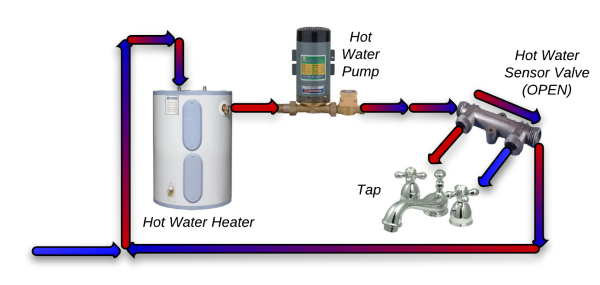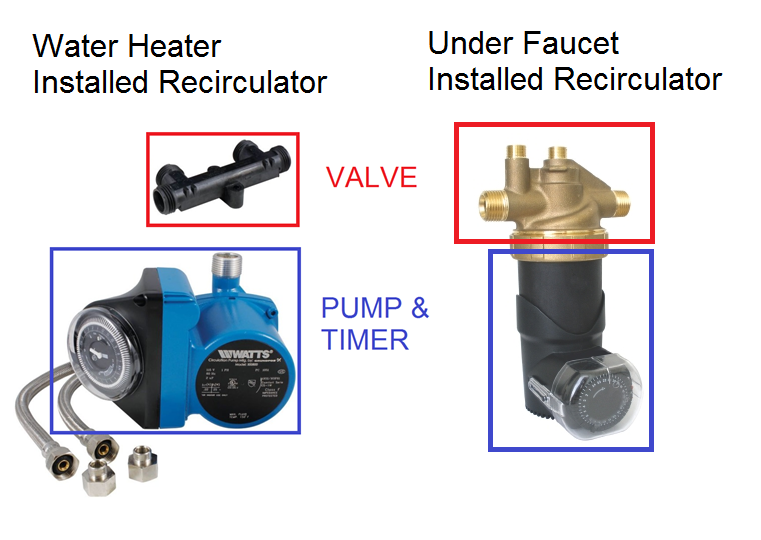How Does A Hot Water Recirculation System Work?
Hot water recirculation systems, also known as hot water pumps, serve to make hot water immediately available at all water taps in your home. This includes shower and bathtub faucets as well as kitchen and bathroom sinks.
Without a hot water recirculator, water sits stagnant in your pipes while not being used thereby reaching the ambient atmospheric temperature. This ambient temperature is usually somewhere around 70 degrees during the summer and as low as 35 degrees during the winter. In some extreme cases, the water will drop below freezing causing your pipes to freeze.
A hot water recirculator will constantly push hot water through your pipes to ensure that hot water is available nearly instantly at all of your taps.

Types of Hot Water Recirculator Systems
The main difference between most of the systems we’ve reviewed is the installation location. The two types are Water Heater Installed Recirculators and Under Faucet Installed Recirculators.
Water Heater Installed Recirculators
The most popular models are of this type and have two parts. The main part, which is the pump itself (and perhaps timer), is installed right next to or right on top of the water heater (which is usually in your garage or a utility closet). This piece needs to be plugged into a wall outlet.
The second part is a piece called a Sensor Valve that is placed under the sink that is furthest away from your water heater (this is because theoretically, this faucet should be the coldest one). This piece is a non-electrical mechanical valve that opens and closes based on the water temperature trying to pass through it. This, coupled with the pump providing a constant pressure, ensures that hot water is readily available.
Under Faucet Installed Recirculators
These systems come in one piece rather than two. That is, both the valve and pump are located within the same unit. This type of recirculator needs to be installed under the faucet furthest away from your heater.
The three negatives of this approach are (1) you must have a cabinet under your sink to contain the pump (assuming you don’t want it to be visible), (2) your cabinet must have an outlet to plug the pump in, and finally (3), if the check valve fails in one of these units, you’ll have to replace the whole device rather than just the broken part. If you do have a cabinet and an outlet under your sink, or you don’t care about the recirculator being visible, then these units may be a better option when compared to the water heater installed units. The main draw in that situation is that you only need to install one piece rather than two.
Hot Water Recirculator System Installation
Read my full article on the installation process complete with pictures and videos: Installation
This is an easy DIY project. Installing most hot water recirculation systems is a fairly simple task that anyone with even a little bit of household handyman work should be able to do. 1 hour should be enough time to get the system up and running fully no matter which type of unit you choose.
The only reason that a plumper would need to get involved is if the pipes going into your main hot water heater or faucet are very stiff. If they are very stiff, the project is still manageable, but you’ll have to do a little extra work to fit some bendable piping in the needed places.
Measurable Benefits
Time:
Without a hot water recirculation system:
Time to 95° F (shower): ~2-3 minutes
Time to 120° F (washing dishes): ~3-4 minutes
With a hot water recirculation system:
Time to 95° F (shower): 2 seconds
Time to 120° F (washing dishes): 4 seconds
Water Saved:
Having a hot water recirculation system saves water by not having to run the faucet while waiting for hot water. Watts claims that using their system will save the average user 11,000+ gallons of water each year. Based on my analysis here, 5,000-10,000 gallons per year is a reasonable figure.
Financial Return on Investment:
There are sources that point to positive ROIs and negative ROIs for hot water recirculation systems. There are too many factors to consider to give a reasonable estimate as to what the return will be for your home. These factors include how many feet of pipe, pipe insulation, other heat loss factors, how often water is run, time between running usage of water, water prices, electricity prices, and more. My analysis here shows that over 5 years, my total investment will be a little less than $100 per year. Sound high? Heat loss in the pipes is the often overlooked factor.
Summary:
If saving money is your main goal for getting a system, you will probably be disappointed, but if your main goal is to get hot water quickly or save thousands of gallons of water, a hot water recirculation system is the right choice for you.

